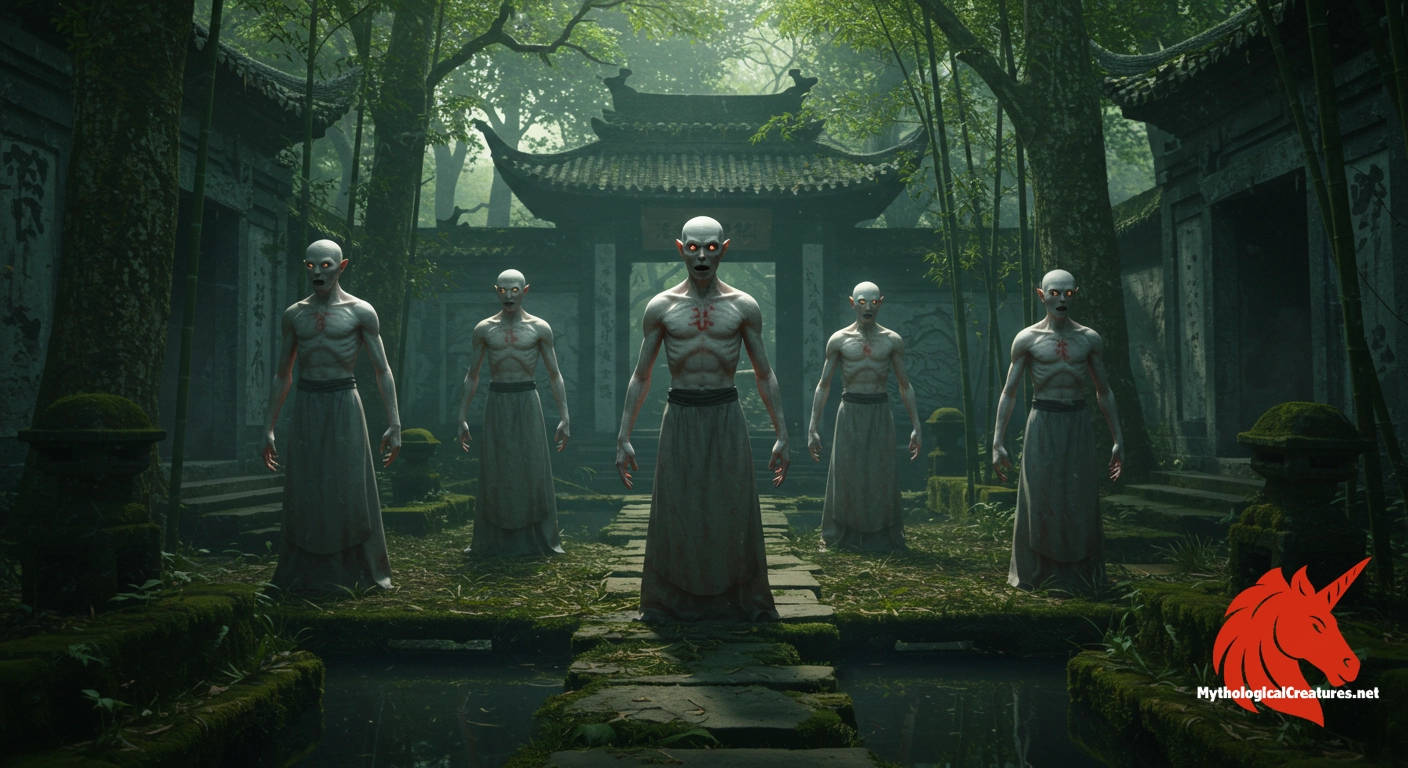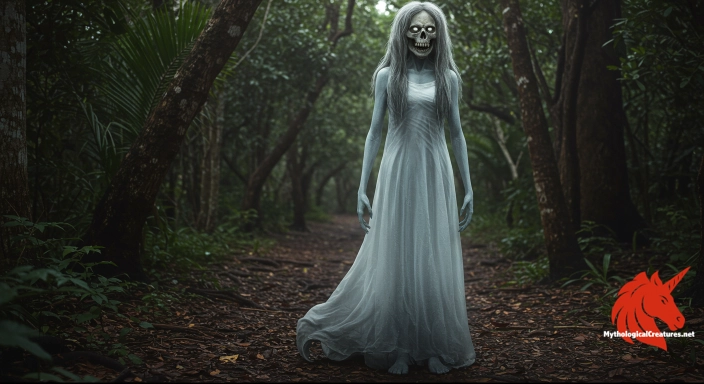Wutong Shen: Wutong Shen are a group of five sinister one-legged deities from southern China known for their deceptive, seductive nature and supernatural curses.

Wutong Shen
Wutong Shen - Wutong Shen serve as cautionary figures highlighting the dangers of uncontrolled desire and the potential for malevolent supernatural intervention in human affairs.
Origins & First Encounters
Hailing from the rich tapestry of southern Chinese folklore, the Wutong Shen are a cadre of five enigmatic deities whose origins date back to the Tang dynasty. Their early appearance in local traditions reflects a time when supernatural explanations were sought for mysterious afflictions. The deities, also known as Wulang Shen, emerged amidst a cultural milieu that sought to understand and control the forces of desire and chaos. Their reputation as one-legged demons mixes the unsettling with the alluring, blurring the lines between divine seduction and malevolent trickery. These figures were embraced by communities in the southern regions as both objects of fear and symbols of taboo transgression. Their myth served not only to explain inexplicable fits and illnesses but also to caution against the dangers of unchecked passion. Over time, their stories have been interwoven with local customs, rituals, and moral teachings that reflect the complexities of human desire. Their enduring legacy continues to provoke both horror and intrigue, making them a compelling subject in the study of Chinese myth and folklore.
Source Texts & Tale Variants
Ancient texts and local oral traditions provide a window into the multifaceted nature of the Wutong Shen, though no single source captures the full spectrum of their character. Early records from the Tang dynasty recount spectral figures associated with seduction and sorrow, forming the backbone of later interpretations. Temple inscriptions and ritual documents from various southern regions hint at their sinister activities and their role in causing mysterious ailments. Folkloric ballads and operatic narratives expand on these early accounts, sometimes transforming the deities into characters of tragic seduction. Variants of their story reveal a spectrum of interpretations, from demonic oppressors to symbolic embodiments of dangerous desire. Some narratives suggest that their ability to disguise themselves as attractive gentlemen was a deliberate ploy to prey on vulnerable women. Diverse local tales contribute differing details about their powers, rituals associated with them, and the consequences of their encounters. This array of sources, spanning literary, oral, and ritualistic traditions, underscores the deities’ complex role in the cultural imagination.
Form & Powers
Visually, the Wutong Shen are depicted as one-legged demons whose anomalous physique is both fascinating and grotesque. Their singular leg, strong and imposing, sets them apart from the typical representations of supernatural beings, hinting at both their agility and inherent imbalance. Often, they bear a handsome countenance when in disguise, cloaked in the guise of a refined gentleman, a testament to their seductive prowess. Detailed portrayals in ancient paintings show flowing robes and subtle yet unnerving facial features that combine allure with a hint of malevolence. Each of the five deities is rendered with slight variations in expression, suggesting individual temperaments beneath their common demonic form. Their eyes, frequently described as deep and mesmerizing, seem to harbour a dangerous promise that belies their monstrous nature. Artistic depictions sometimes include ornate accessories or talismanic marks that symbolise their supernatural essence. The intricate juxtaposition of beauty and deformity in their physical description vividly encapsulates the dangerous seduction at the heart of their myth.
Regional Faces
Across various southern regions of China, the characterisation of the Wutong Shen has been uniquely tailored to resonate with local beliefs and social contexts. In some rural communities, they are viewed as capricious spirits who embody the unpredictable forces of nature and desire. Folk traditions in provinces such as Guangdong and Fujian often present them as both seducers and agents of misfortune, casting a shadow of caution over interactions between the supernatural and the mortal. Urban reinterpretations sometimes temper their fearsome image, presenting them as enigmatic figures caught between human fragility and divine retribution. Local festivals and exorcism rites have incorporated elements of the Wutong myth, indicating how deeply their legend has permeated community practices. Variations in dress, accessory details, and even the symbolism of their one-legged form often reflect regional artistic conventions and moral paradigms. In some areas, the deities are invoked in cautionary tales to warn against the perils of succumbing to forbidden desires. This regional diversity not only enriches their myth but also highlights the adaptability of folklore as it interacts with evolving cultural landscapes.
Cultural Parallels
The myth of the Wutong Shen bears intriguing similarities to other supernatural seducers across global traditions. Much like the succubi of Western lore, these deities wield charm as a weapon, luring victims into dangerous encounters with their beguiling appearances. Parallels can also be drawn with East Asian fox spirits, which similarly blend beauty with malevolent intent to serve as both seductresses and tricksters. The notion of a seductive yet inherently threat-laden spirit recurs in many mythologies, underscoring common human anxieties about the power of desire. In comparative analysis, the one-legged motif, though uncommon, evokes images of imbalance and otherworldliness found in various folklore traditions. These associations hint at a universal archetype where seductive allure and moral peril are intertwined in the persona of a supernatural being. The similarities extend to the narratives surrounding both groups, where seduction is depicted as a catalyst for downfall and misfortune. By examining these cultural parallels, one can appreciate how the Wutong Shen uniquely encapsulate a blend of beauty, danger, and the timeless allure of the forbidden.
Legacy & Modern Evolution
The historical evolution of the Wutong Shen reflects a complex interplay between tradition and modern reinterpretation. Their earliest representations, rooted in Tang dynasty iconography, depicted them as unremittingly sinister figures whose malevolence was both feared and revered. Over the centuries, artists and storytellers have reimagined these deities, gradually imbuing them with layers of complexity that speak to evolving societal concerns about desire and control. In modern times, the Wutong Shen have transcended their origins to become popular subjects in literature, film, and digital media, often symbolising the eternal conflict between passion and peril. Contemporary portrayals tend to highlight their dual nature, merging elements of the classical demonic figure with modern psychological horror. Their image now serves as a powerful metaphor for the dangers inherent in surrendering to temptation, resonating with audiences across different generations. Theatre productions and art installations frequently explore their enigmatic appeal, reflecting a broader cultural fascination with the darker aspects of human nature. The continuing reinterpretation of their myth demonstrates how ancient deities can be recontextualised to mirror the complexities of modern existence.
Interesting Fact
An unusual trait of the Wutong Shen is their depiction as one-legged demons, which not only distinguishes them visually but also symbolically represents the imbalance and treacherous nature of uncontrolled lust in traditional Chinese culture.
Quick Creature Info
Our Mythic Legendary Rating:

Also Sometimes Known As:
Habitat:
Supernatural Powers:
Physical Attributes:
Abilities:
Behavior:
Lore:
References
Discover Another Mythical Legend You May Not Have Heard Of?
Uncover the mysteries of ancient folklore and expand your knowledge of legendary beings from cultures around the world.
Dare to Meet the Sayona....
Curated by the Mythological Creatures Team (rev. May 2025)
